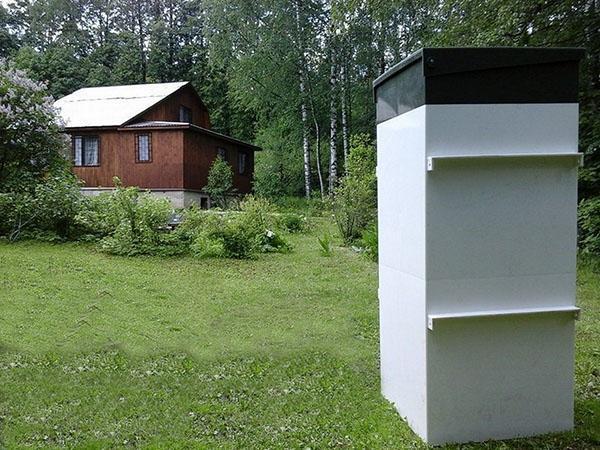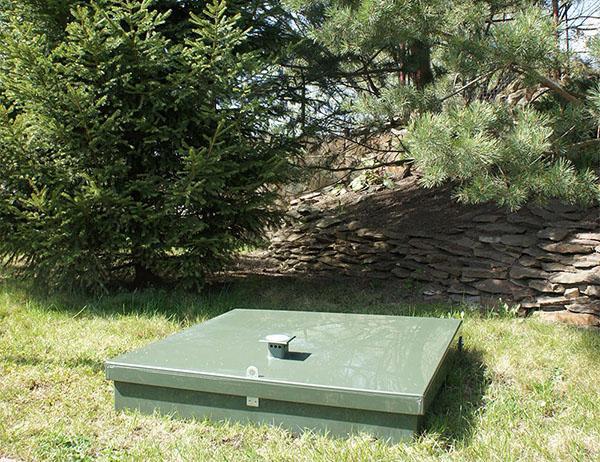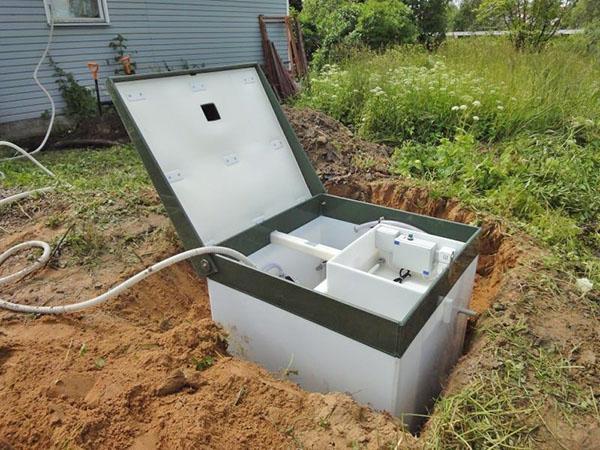What is the Autonomous Sewerage Topas for and how to install it in the country
 The autonomous sewage system Topas installed in the country will save the owners of the site from many problems. In order to understand what the Topas autonomous sewage system is, first of all, you need to understand the following issues:
The autonomous sewage system Topas installed in the country will save the owners of the site from many problems. In order to understand what the Topas autonomous sewage system is, first of all, you need to understand the following issues:
- advantages of the system and its disadvantages;
- the principle of operation and the device of the purification structure;
- features of functioning and maintenance.
Let's consider each of the designated points in more detail.
Advantages and disadvantages of the septic tank Topas

The reason for the great popularity of the autonomous sewage system Topas among the domestic user is its following advantages:
- Compact dimensions, thanks to which the system occupies an area of no more than one square meter.
- The ability to install almost anywhere in the local area.
- Convenience of waste disposal (the purified water obtained at the outlet can be used for watering plantings or other needs).
- Ease of maintenance that does not require the involvement of third-party workers.
Sludge accumulating at the bottom of the Topas sewer sump can be used as an organic fertilizer.
In addition to the functional advantages, devices of this class surpass their counterparts in a number of technical parameters. These include the following design features:
- The lid of the septic tank is located just above ground level, which greatly facilitates access to its internal spaces.
- The weight of the structure increases significantly due to the accumulating waste of processing.
- Thanks to this, industrial installations Topas are reliably fixed in the ground.
- The robust body of the structure provides excellent thermal insulation.
- Discharge of treated water is carried out in the system by gravity.
- This eliminates the need for additional pumping equipment.
Among the significant disadvantages of the Topas septic tank is its dependence on power supply, as well as its relatively high cost. The indicated disadvantages of the treatment system must be taken into account before purchasing it.
 To do this, you should worry in advance about the presence of an electrical connection near. If necessary, an extension cable of the required length is thrown from the nearest household outlet to the septic tank.
To do this, you should worry in advance about the presence of an electrical connection near. If necessary, an extension cable of the required length is thrown from the nearest household outlet to the septic tank.
Principle of operation

To understand the principle of operation of Topas, it is enough to know that the following series of sequential operations are carried out in this installation:
- First, the water contaminated with waste enters the receiving chamber through the sewer pipe, where large particles settle to the bottom due to their weight.
- Further, by means of a jet pump (airlift), the liquid is moved to a separate compartment with active bacteria.
- Here, its decomposition takes place with simultaneous cleaning from contaminants that are not filtered in the receiving sedimentation tank.
- Sludge is used as a filtration element, which completely sucks up all the remaining dirt.
- Then it, mixed with water, enters the secondary settling tank, where it gradually settles to the bottom.
- From it, water cleared of dirt is removed to the outside.
To accelerate the decomposition of liquid waste, air is pumped into the active treatment compartment by special compressors.
The sludge used as a cleaning element is designed for a certain period of validity.At its end, the old train is removed from the system and replaced with a new one.
Thanks to the described principle of operation of the Topas autonomous sewage system, the water at the outlet of the system is purified by 98%. The specified indicator fully meets the current sanitary standards. In total, in the work of a septic tank, four filtration sections can be distinguished, at each of which processing is carried out corresponding to its purpose. Wastes entering it are consistently cleaned, which ends with their almost complete disposal.
How the autonomous sewage system Topas works

When familiarizing with the principle of operation of septic tanks of this class, such components as a receiving chamber and a sludge stabilizer were noted. In addition, the structure includes the following mandatory elements:
- coarse fraction filter;
- aerator receiving chamber (aerotank);
- secondary sedimentation tank (pyramid);
- air intake, set of compressors and other necessary equipment.
Additional details of the Topas septic tank device include the presence of a hatch and a cover used to inspect the insides. A sludge pumping hose is also an obligatory part of the cleaning system.
Since the type of treatment plant in question belongs to volatile installations, an electrical cable must be connected to it, which is necessary to power the compressor system.
Features of different models
 Differences in the models of industrial plants Topas mainly relate to the performance indicator, as well as their dimensions. There are two popular models of this system, produced under the brands Topas-5 and Topas-10.
Differences in the models of industrial plants Topas mainly relate to the performance indicator, as well as their dimensions. There are two popular models of this system, produced under the brands Topas-5 and Topas-10.
In certain situations, when considering the Topas septic tank models, the dimensions of the products are of decisive importance.
So, for small-sized summer cottages, the Topas-5 model (with a capacity of no more than a cubic meter) seems to be the only possible solution.
 The Topas-10 system, which is more powerful in performance, is usually purchased by the owners of suburban farms with a large serviced area. The model range of products of this brand also includes samples intended for use in country hotels and cottage villages.
The Topas-10 system, which is more powerful in performance, is usually purchased by the owners of suburban farms with a large serviced area. The model range of products of this brand also includes samples intended for use in country hotels and cottage villages.
Cleaning system maintenance
 Everything related to maintaining the performance of septic tanks of this type should be given special attention. The latter is explained by the fact that the literacy and timeliness of maintenance of the Topas sewage system can significantly extend the life of its operation.
Everything related to maintaining the performance of septic tanks of this type should be given special attention. The latter is explained by the fact that the literacy and timeliness of maintenance of the Topas sewage system can significantly extend the life of its operation.
To maintain the septic tank in good condition, it is not allowed to dump the following items and substances into the sewer network:
- the remains of vegetables, as well as construction waste;
- scraps of plastic and rubber products;
- water treated with oxidants and chlorine-containing substances ("Whiteness", "Persol");
- the liquid used to wash the filters;
- medications;
- clumps of hair from pets.
This list can be supplemented with acids, alkalis, as well as antifreezes and automotive oils.
Preventive maintenance of the cleaning system should be carried out regularly. According to the instructions attached to the device, it is carried out in the following order:
- first, the operability of all functional units of the system is checked;
- then the quality of the water purified from pollution is visually assessed;
- if necessary, the sludge accumulated in it is removed from the receiving chamber (for this, an airlift or a special drainage pump is used);
- in case of severe wear of the compressor membrane, it is replaced with a new product;
- at the final stage of work, the container for collecting solid particles is cleaned.
All these operations are recommended to be performed at least 3-4 times per season.
It is necessary to remove and clean the filter elements according to the instructions every month, and the aeration elements will need to be replaced once every 12 years. A set of measures for the care septic tanks Topas also includes such mandatory activities as calling the sewer truck. If you want to save money on cleaning sedimentation tanks, the operation to remove sludge and solid waste can be performed independently.
In conclusion, we note that most of the owners of private households who constantly use the autonomous Topas sewage system are very satisfied with its quality. In their opinion, this type of sewage treatment plant (despite the relatively high cost) guarantees uninterrupted operation during the entire period of operation.